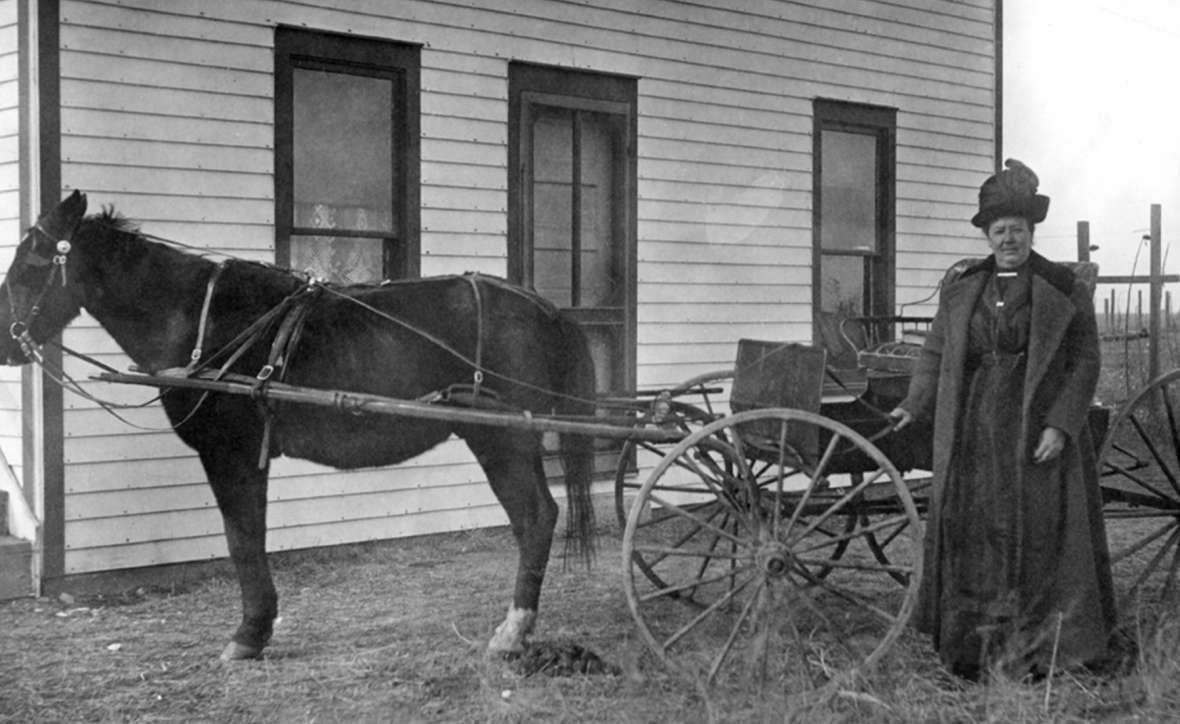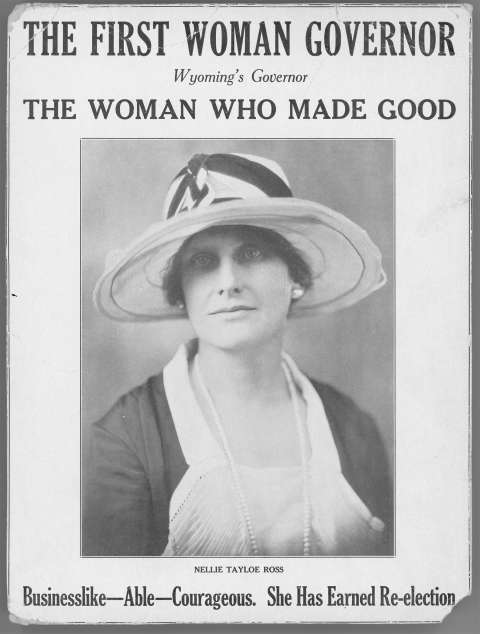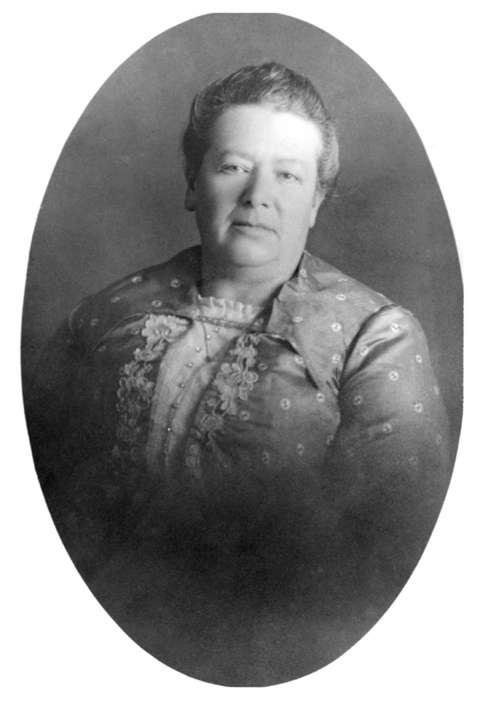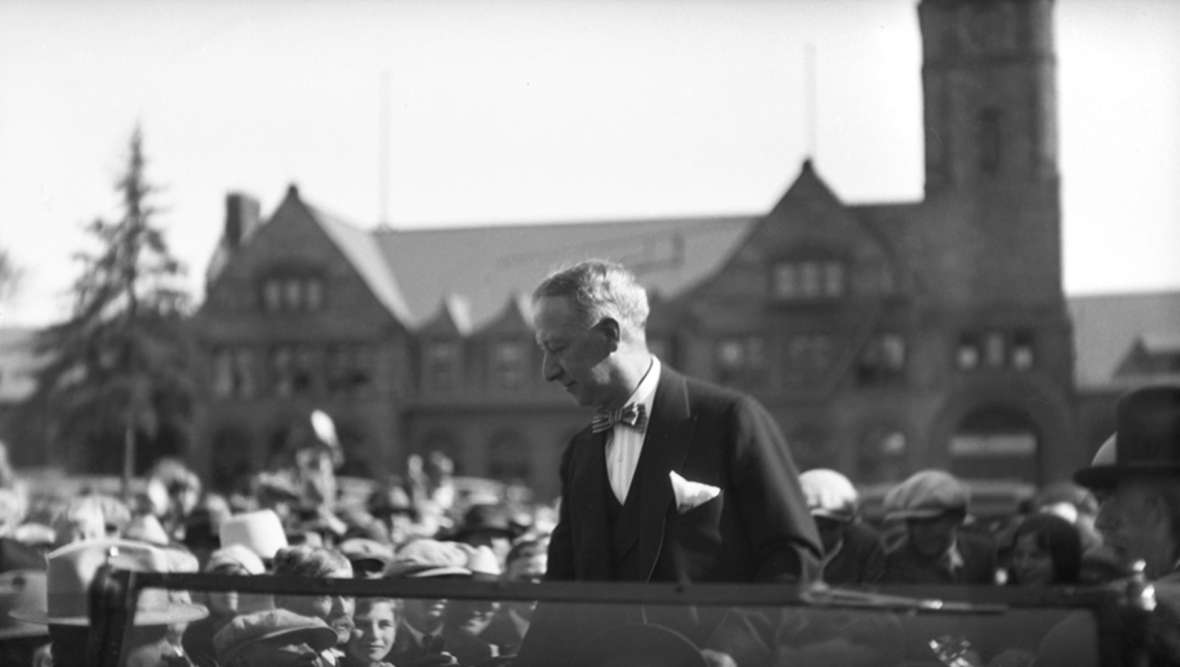- Home
- Encyclopedia
- Minnie Fenwick, Nellie Tayloe Ross and The Pres...
Minnie Fenwick, Nellie Tayloe Ross and the Presidential Campaign of 1928
In Wyoming as around the nation, Prohibition was central to the 1928 presidential campaign. Was the ban on alcohol successful or a failure? Should it continue or be done away with?
Cheyenne-based temperance activist Minnie Fenwick was quite clear where she stood on the issue, and critical of anyone who disagreed with her. Former Wyoming Gov. Nellie Tayloe Ross, however, navigated a more complicated route that year—among “drys,” “wets,” her own political record and her conscience.
By the late 1920s, Fenwick was well known around Wyoming for her anti-alcohol activities. She had served five years as state president of the Woman’s Christian Temperance Union and 17 years as president of her local union—as the WCTU’s local chapters were called. She had also served as state corresponding secretary, state treasurer and state vice president. In these capacities she traveled widely and spoke in nearly every town in Wyoming—even in a Mormon church building in little Cowley, Wyo., in the northern Bighorn Basin, “where people have said it was a hard task to get permission to speak,” family friend Ida Hintze recalled later.
Ross, meanwhile, succeeded her husband as governor in 1924 after his unexpected death. She narrowly lost a re-election bid in 1926, but already by that time was known across the country as the nation’s first woman governor—and a gifted orator. By 1928 she was active in the Democratic National Committee and spoke widely on behalf Gov. Al Smith of New York, Democratic nominee for president. At the Democratic Convention, she gave the speech seconding Smith’s nomination and even was mentioned as a possible candidate for vice president. Along with Eleanor Roosevelt, she was appointed co-vice chairman of the Democratic National Committee and national director of women’s activities. She spoke on Smith’s behalf throughout the campaign.
Smith, of New York City, was the first Roman Catholic to run for president. In his time as governor he and the New York legislature instituted a number of social programs understood in later years as predecessors of President Franklin Roosevelt’s New Deal of the 1930s. Smith was a “wet”—he believed Prohibition should be repealed.
His opponent, Republican Herbert Hoover, was a mining engineer with roots in Iowa and Oregon. He ably administered U.S. government programs for famine relief in post-World War I Europe and served as secretary of commerce in the Harding and Coolidge administrations of the 1920s. Hoover was a Quaker and a “dry”—a supporter of Prohibition.
Prohibition had been in effect nationwide since 1919. Wyoming had finally joined the states around it by banning liquor statewide late in 1918, shortly before the end of World War I. But opinions may have been shifting by the time Nellie Tayloe Ross was governor. She took the political risk of firing two men in high positions in state government, one for drunkenness and the other for taking bribes from bootleggers and drunkenness. Those decisions probably worked against her; she lost her re-election bid in 1926.

Minnie Fenwick, homesteader, minister temperance activist
Minnie Dixon was born in 1865 in Bloomington, Ind., moved with her parents to Iowa in 1879 and graduated from high school there. In 1882 she married Cyrus Fenwick, a carpenter and builder. They moved to Illinois and back to Iowa, eventually raising four children, Willie, Leslie, Mabel and Vay Inel. Both Minnie and Cyrus were ordained Congregational ministers by 1900.
In May 1907, Cyrus Fenwick traveled to Cheyenne, leaving Minnie and their now grown children in Iowa. He filed on a homestead near Luther, later named Burns, a hamlet 17 miles from the Nebraska line east of Cheyenne. He built a schoolhouse for nearby Hillsdale, houses in Luther, houses on homesteads and in other towns in the area and finally, a “shack” for their homestead.
He preached the first sermon and gave the first public prayer in Luther. He also held services in other nearby small towns. But his wife soon took over much of this work while he continued to improve their homestead and work as a carpenter. She held church services and officiated at weddings and funerals in three nearby towns: Egbert, Pleasant Hill and North Burns.
Looking out the train’s window as she came into Wyoming the first time and approached Cheyenne, Minnie later told Ida Hintze, “I was sick to see such bare land.” The Fenwicks survived blizzards and hard times on the homestead. In winter Cyrus and Minnie kept a lighted lamp in their window at night, a landmark for family and neighbors.
WCTU and politics
In a letter dated Aug. 22, almost certainly from 1928, the presidential election year, a Sheridan woman wrote WCTU officer Fenwick, “Is there no way of ridding this town of saloons?” Saloons at that time were illegal, so she was talking about what we now call speakeasies. “They are there, just as they used to be, and it breaks my heart to see loved ones in such a condition. … [P]lease do something—I cannot stand it.”
Fenwick forwarded a copy to C. Watt Brandon, editor of the Sheridan Journal, along with a letter of her own. “The Woman’s Christian Temperance Union,” Fenwick wrote, “is vitally interested in the election of a president whose stand is unquestioned as to the prohibition question.” She was referring to Hoover. “Bootleggers in the alley,” she continued, “bootleggers in soft drink parlors, or any place where ...[liquor] is being sold, are just as much of a law breaker as the man who robs your home. .…

“The W.C.T.U. is in sympathy with this woman, and we hope that soon conditions will change, even if we have to import some Carrie Nations from Kansas to help us. … We are in the right and for the right we will ever stand, and we will try to better conditions soon by legislation which will send the bootlegger out on the streets to break rocks.” The reference to Carrie Nation was something like a threat. For decades by this time, Nation was known for smashing liquor bottles and bar fixtures with a hatchet in Kansas saloons. The “break rocks” remark is a reference to convict labor.
Wyoming press eyes Prohibition
In 1928, the WCTU endorsed Hoover and the Wyoming press reported extensively on Fenwick’s activities. Many newspaper clippings from this period are preserved unidentified and undated, in a file at the Wyoming State Archives.
Most articles were fair and balanced. One paper reported, “Tentative plans for a pre-convention campaign against Governor A. Smith is expected to be formulated next week at a conference of W. C. T. U. workers in Denver. … In support of her belief that Smith will be the target of conference remarks Mrs. Fenwick calls attention to the fact that Mrs. Ella A. Boole, national president of the W. C. T. U., in an address early this week before a meeting of this organization in New York City, was outspoken in her reference to Smith.”
A Wyoming Eagle editorial, countering some of Fenwick’s reported remarks against that paper, added, civilly, “Mrs. Fenwick proclaims her earnestness. We have never doubted it. Repeatedly we have stated our belief in her sincerity and that of most of her fellow workers.” The editorial continues, “Of so many reformers, Mrs. Fenwick included, however, it seems so peculiarly true that they are utterly intolerant of the views of others.”
Not all editors were as civil, however.
“Mrs. Minnie Fenwick of Cheyenne, Grand Exalted Pullet of the W. C. T. U., has been meandering mournfully through the length and breadth of Wyoming cackling noisily concerning her discoveries of cases in this semi-arid state,” wrote A. J. Hazlett of the Wyoming Inland Oil Index. “She threatens to peck and scratch any ambitious candidate for public office who may ever have had his breath tainted with even so much as a strong glass of ginger ale. Go to it, Minnie. We’re for you,” Hazlett concluded. “Like most editors we are politically dry and personally wet. Figure the percentage for yourself!”
Ross navigates between wet and dry
When Nellie Tayloe Ross began campaigning for Smith, a Cheyenne paper noted that while in office, “Governor Ross employed all the power and prestige of her office in the effort to enforce prohibition. … She removed one sheriff and forced the resignation of another for laxity in enforcing the [prohibition] law, displaying a courage that is not often to be found in the executive office. ... In every declaration she has made for Governor Smith, Governor Ross has proclaimed herself a prohibitionist.”

But Fenwick was careful to separate herself and the WCTU from any connection with Ross. In July, Fenwick wrote to the Sheridan Journal that recent “statements made by a wet Republican reporter … [were] nothing short of a slanderous attack upon the W. C. T. U. and myself. … Our fight is against Governor Smith as a wet. … We are out to defeat him for president. Again, I did not say the things he credited to me about Mrs. Ross. ‘That she severed her relations with the dry forces when she advocated the candidacy of Governor Smith for president.’ I helped elect Mrs. Ross, as well as W.E. Ross, believing her to be a dry, but would not support her again for any office.”
Around the same time, Fenwick wrote to another paper, “Reports are being circulated in Cheyenne and places where ex-Governor Nellie Tayloe Ross is speaking advocating the candidacy of Alfred Smith for president of the United States, that she is ‘bone dry’ and some say she is a member of the Woman’s Christian Temperance Union of Wyoming. The facts are: First, that she is not and never has been a member of this organization, not having signed the total abstinence pledge or paid the dollar dues required of all who join our organization. … [I]n September, 1926, the Cheyenne Union of this city made her an honorary member for the work she was doing for law enforcement while she was governor.” Fenwick added that Ross said [in supporting Smith] she was obeying the dictates of her conscience, “in doing so, she is not beholding to the W. C. T. U. and is in no way connected with it.”
In the end, Hoover won in a landslide with 59 percent of the popular vote and all but eight states in the Electoral College. In Wyoming the margin was even wider, nearly two to one. Of the state’s 23 counties, only Sweetwater went for Smith.
Ross remained active in Democratic politics and campaigned hard to organize women to vote for Roosevelt in his landslide in 1932. By that time the stock market had crashed and the Great Depression was devastating the nation. In return for her support, Roosevelt named Ross director of the U.S. Mint, a position she held for 20 years.
As for the Fenwicks, Cyrus founded a photography studio in Burns, and once a week played a silent movie there. When carpentry work in and around Burns slackened, the couple moved to Cheyenne in 1925, where Cyrus continued as a builder. Both died in Cheyenne; Cyrus in 1935 and Minnie in 1938.

Resources
Primary Sources
- “The Fanatical Mr. Wade Runs True to Form.” Unidentified newspaper clipping, n.d. Rev. Minnie Fenwick collection, Collection H71-93, Wyoming State Archives, Cheyenne, Wyo. (Hereafter WSA) Also available at Rocky Mountain Online Archives (hereafter RMOA), accessed Feb. 22, 2020 at https://rmoa.unm.edu/docviewer.php?docId=wy-arh71-93.xml.
- Hazlett, A. J. “A Personally Wet, Politically Dry Editor Spurs Minnie.” Wyoming Inland Oil Index, n.d. Rev. Minnie Fenwick collection, Collection H71-93, WSA. Also available at RMOA, accessed Feb. 22, 2020 at https://rmoa.unm.edu/docviewer.php?docId=wy-arh71-93.xml.
- Hintze, Ida Elizabeth. “Minnie and Cyrus Fenwick, Pioneer Ministers of Burns.” Rev. Minnie Fenwick collection. File includes numerous newspaper clippings probably from 1928, most undated and unidentified. Collection Number H71-93, WSA. Also available at RMOA, accessed Feb. 22, 2020 at https://rmoa.unm.edu/docviewer.php?docId=wy-arh71-93.xml.
- “Minnie Fenwick Denies Charges Accredited Her By Paper Here.” Sheridan Journal, July 16, 1928. Rev. Minnie Fenwick collection, Collection H71-93, WSA. Also available at RMOA, accessed Feb. 22, 2020 at https://rmoa.unm.edu/docviewer.php?docId=wy-arh71-93.xml.
- “Mrs. Ross Is Not And Never Has Been W. C. T. U. Member.” Unidentified newspaper clipping, n.d. Rev. Minnie Fenwick collection, Collection H71-93, WSA. Also available at RMOA, accessed Feb. 22, 2020 at https://rmoa.unm.edu/docviewer.php?docId=wy-arh71-93.xml.
- “Pre-Convention Plans To Be Discussed Soon By Western W.C.T.U.” Unidentified newspaper clipping, n.d. Rev. Minnie Fenwick collection, Collection H71-93, WSA. Also available at RMOA, accessed Feb. 22, 2020 at https://rmoa.unm.edu/docviewer.php?docId=wy-arh71-93.xml.
- “Those Who See Not As We See.” Wyoming Eagle, n.d. Rev. Minnie Fenwick collection, Collection H71-93, WSA. Also available at RMOA, accessed Feb. 22, 2020 at https://rmoa.unm.edu/docviewer.php?docId=wy-arh71-93.xml.
Secondary Sources
- “1928 United States presidential election in Wyoming.” Wikipedia, accessed Feb. 27, 2020 at https://en.wikipedia.org/wiki/1928_United_States_presidential_election_i....
- “Al Smith.” Wikipedia, accessed Feb. 22, 2020 at https://en.wikipedia.org/wiki/Al_Smith.
- “Carrie Nation.” Wikipedia, accessed Feb. 25, 2020 at https://en.wikipedia.org/wiki/Carrie_Nation.
- “Herbert Hoover.” Wikipedia, accessed Feb. 22, 2020 at https://en.wikipedia.org/wiki/Herbert_Hoover.
- Rea, Tom. “The Ambition of Nellie Tayloe Ross.” WyoHistory.org, accessed Feb. 28, 2020 at /encyclopedia/ambition-nellie-tayloe-ross.
- Scheer, Teva J. Governor Lady: The Life and Times of Nellie Tayloe Ross. Missouri Biography Series, edited by William E. Foley. Columbia, Mo. and London: University of Missouri Press, 2005, 124-143, 242-245.
- Thompson, Martha. “Denver Man Looks Into Burns History.” The Wyoming Eagle, Oct. 8, 1968. Rev. Minnie Fenwick collection, Collection H71-93, WSA. Also available at RMOA, accessed Feb. 22, 2020 at https://rmoa.unm.edu/docviewer.php?docId=wy-arh71-93.xml.
For further research
- “Prohibition in Wyoming.” Wyoming PBS, a 27-minute video accessed Feb. 27, 2020 at https://video.wyomingpbs.org/video/wyoming-pbs-documentaries-prohibition-in-wyoming/. Access may require PBS membership.
Illustrations
- The two photos of Minnie Fenwick and the photo Al Smith are from Wyoming State Archives. Used with permission and thanks.
- Nellie Tayloe Ross’s re-election poster is from the American Heritage Center at the University of Wyoming. Used with permission and thanks.
